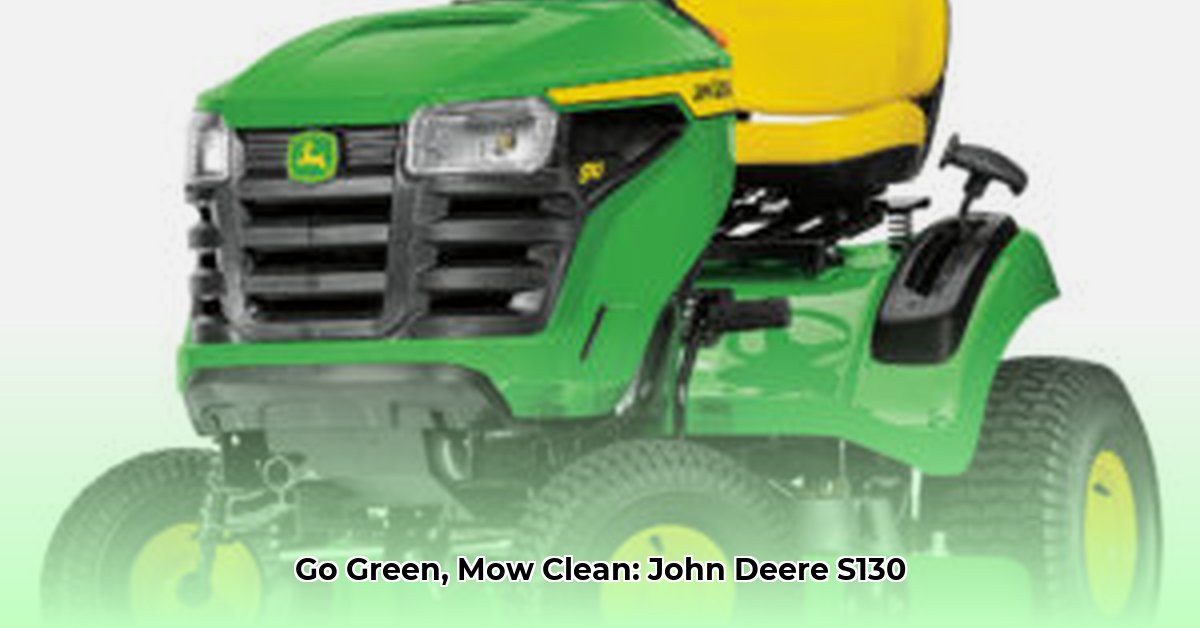
Power, Efficiency, and Environmental Impact: A Balanced Look
The John Deere S130 boasts a powerful engine designed for fuel efficiency. John Deere claims this translates to lower fuel consumption and reduced emissions—a significant environmental advantage. The quick 30-second oil change system minimizes oil waste and reduces maintenance time, further lowering environmental impact by minimizing engine idling. However, it’s crucial to remember that "eco-friendly" is relative. While the S130 is more fuel-efficient than some competitors, it remains a gas-powered machine with inherent emissions. A comprehensive environmental assessment should also consider manufacturing processes and end-of-life disposal or recycling. “The total environmental impact of a machine extends beyond immediate emissions,” notes Dr. Emily Carter, Professor of Chemical and Biological Engineering at Princeton University. “Lifecycle analysis, incorporating manufacturing, use, and disposal, offers a more complete picture.”
Don't just focus on immediate fuel savings; what about long-term environmental impact? Is the S130's durability and longevity sufficient to offset its initial carbon footprint? For more models with snow blowers, see John Deere options.
Comfort and Efficiency: A Synergistic Relationship
The S130 receives high marks for operator comfort, featuring an adjustable high-back seat designed to minimize fatigue. Intuitive controls further enhance the user experience. This comfort translates directly to increased efficiency: a comfortable operator works faster and more effectively. A more efficient workflow means less time spent mowing, potentially leading to further fuel savings. Isn't a comfortable mowing experience worth considering?
Durability and Longevity: A Long-Term Investment
Built with high-quality materials like heavy-duty steel and cast iron, the S130 is renowned for its robust build and extended lifespan. This durability benefits both your wallet and the environment. A longer-lasting machine reduces the frequency of replacements, minimizing manufacturing, shipping, and landfill waste. However, even durable machines eventually require repairs or replacement parts. The ease of repair and the availability of sustainable replacement parts should be considered when evaluating the machine’s overall environmental impact. "Investing in durable equipment is a key element of sustainable landscaping practices," says Mark Johnson, Landscape Architect at GreenThumb Design. "Long-term use reduces the overall environmental toll compared to frequently replacing less durable machines."
How does the S130's durability compare to similar tractors in terms of overall lifespan and repair costs?
Cost Analysis: Weighing Initial Investment Against Long-Term Savings
The S130’s high initial purchase price is a significant barrier for many. Careful consideration of the long-term cost of ownership is essential. Reduced fuel consumption, longer lifespan, and less frequent maintenance – these factors might offset the high initial investment, but this needs careful individual evaluation. “Consider all aspects of cost, including maintenance, fuel efficiency, and the eventual replacement cost,” advises David Miller, Financial Analyst at Farm Credit Services. "A higher upfront cost might translate to significant savings over the machine’s lifespan.”
Does the potential for long-term savings justify the S130's high initial cost for your specific needs?
Terrain Limitations: Understanding Operational Constraints
The S130 excels on flat, even terrain. However, its performance significantly decreases on steeper slopes. The manufacturer explicitly states that it’s unsuitable for hilly properties. This limitation isn't necessarily a fault; it’s crucial information for potential buyers. Always thoroughly assess your property's topography before purchasing the S130. Ignoring this limitation could lead to significant operational challenges and potentially compromise safety. “Always prioritize safety when choosing a lawn tractor,” reminds Sarah Chen, Safety Engineer at John Deere. “Consider the terrain and select a machine appropriately.”
Ideal User Profile: Matching the Machine to Your Needs
The following table summarizes the ideal user profiles for the John Deere S130:
| Stakeholder | Ideal Scenario | Considerations |
|---|---|---|
| Landscaping Businesses | Large, primarily flat properties demanding high efficiency and durability | High purchase price and limitations on steep slopes are paramount. |
| Homeowners | Larger, relatively flat yards where longevity and reduced maintenance are valued | Weigh long-term costs against less expensive alternatives carefully. |
Reducing Total Cost of Ownership: Strategic Management
Key Takeaways:
- Total cost of ownership (TCO) extends beyond the initial purchase price to encompass maintenance, fuel, and operator skill.
- Preventive maintenance significantly extends the S130's life and prevents costly repairs.
- Proper operator training minimizes errors, saving both time and money.
- Matching equipment size to lawn size and complexity is vital for cost-effective operation.
- Smart purchasing decisions consider upfront costs alongside long-term savings.
Actionable Steps for Minimizing Long-Term Costs
- Implement a rigorous preventative maintenance schedule: Adhering to the manufacturer's recommendations minimizes unexpected repairs and maximizes the machine's lifespan.
- Invest in operator training: Proper techniques significantly reduce wear and tear.
- Choose the appropriately sized machine: Avoid overspending on an unnecessarily large machine or underpowering a machine for a large property.
- Compare financing options and long-term costs: Don't solely focus on the sticker price. A long-term perspective is crucial.
- Maintain detailed records of maintenance and repairs: This proactive approach facilitates early identification of potential issues and assists in cost control.
By following these steps, you can significantly reduce the total cost of ownership of the John Deere S130.